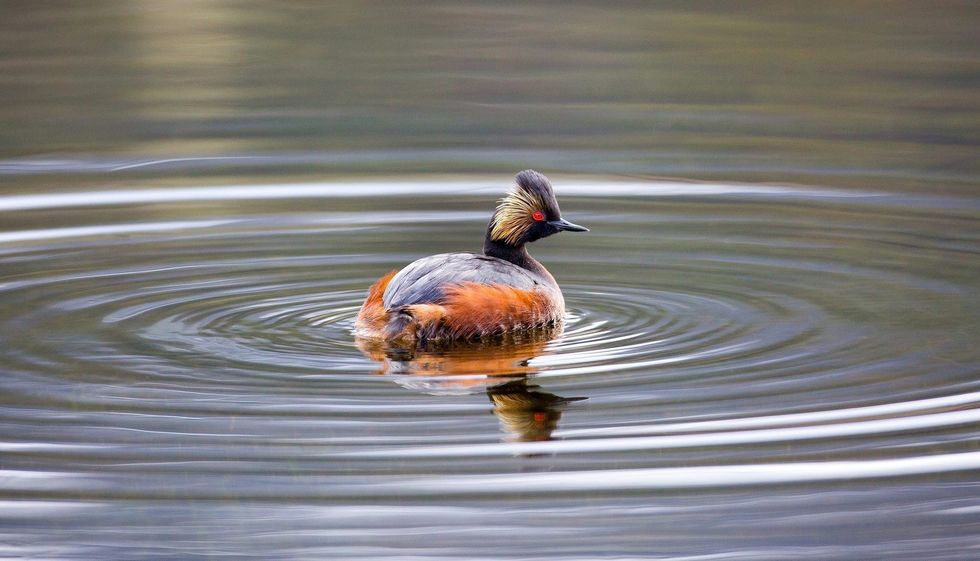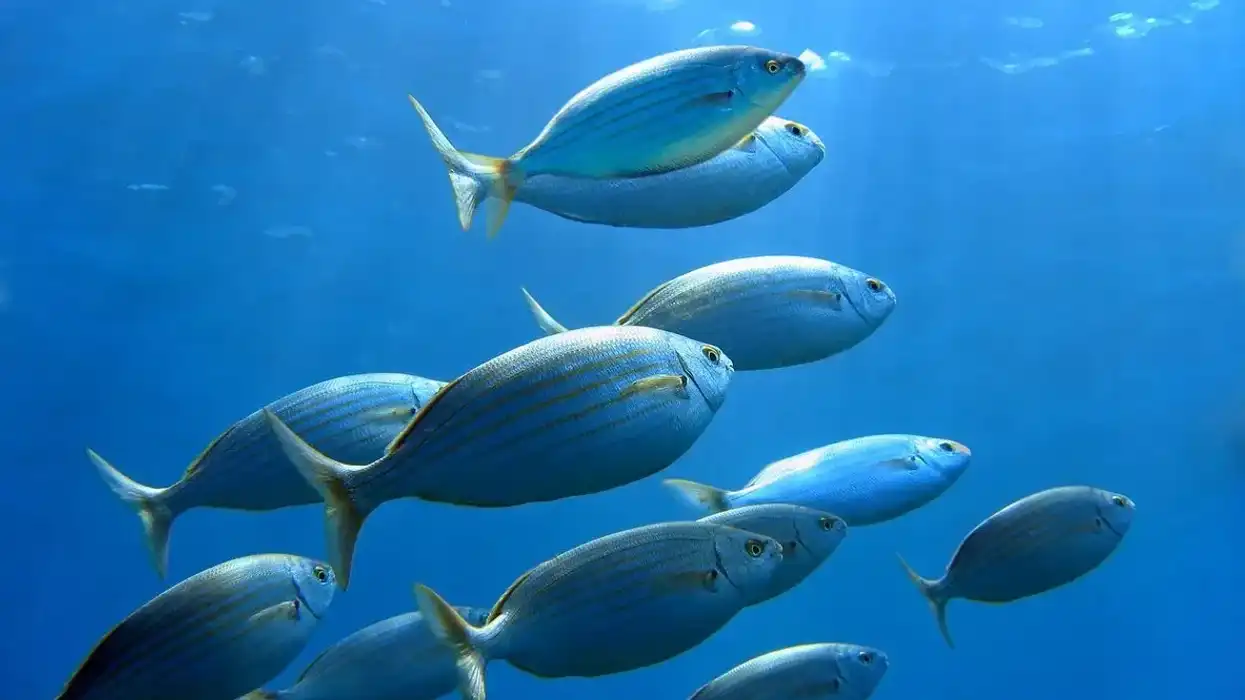The black necked grebe is a wonderful bird that lives in both freshwater and saline water habitats. It has a wide range of distribution and can be found in Europe, South Africa, North America and Asia.
These birds carry a vibrant plumage during their mating season and a normal dull plumage over the rest of the year. They are small aquatic bird species with a good wingspan.
They are very idle and avoid flying as much as they can and only open their wings when it is the time to migrate. They are primarily carnivorous and eat on both invertebrates and vertebrates.
The eat insects, larvae, small frogs, small fishes and other stuffs. All in all, they are very cute looking birds that everyone will love to see.
This was just a small introduction. Ahead in the article, there are amazing facts about this bird while will make you feel insane!
For more relatable content, check out these green warbler facts and mourning warbler facts for kids.
Black-Necked Grebe Interesting Facts
What type of animal is a black-necked grebe?
The black necked grebe (Podiceps nigricollis) is a type of bird from the Podicipedidae family. It is also known in America as the eared grebe. They are found in Africa, Europe, Asia and North America. In Asia, it is found only in some certain parts. It is a type of grebe.
What class of animal does a black-necked grebe belong to?
Eared grebe belong to the class Aves. They belong to the phylum Chordata, order Podicipediformes, family Podicipedidae and genus Podiceps. The scientific name assigned to them is Podiceps nigricollis. They have a small body and are water birds like ducks.
How many black-necked grebes are there in the world?
Black necked grebe (Podiceps nigricollis) also known as eared grebe and are found in the continents of North America, Africa, Asia and Europe. The are considered as Least Concern species.
And because of that their exact population count is not available. But it is vaguely estimated that there are around 3.8–4.2 million individuals of this bird species inhabit this world.
Where does a black-necked grebe live?
The black necked grebe (Podiceps nigricollis) is a water bird from the family Podicipedidae. Black necked grebe breeds in vegetated areas of freshwater bodies. They are commonly seen swimming in freshwater bodies in their habitat. It mainly lives in water and marshry areas near those water bodies like lakes and big ponds.
What is a black-necked grebe's habitat?
Black necked grebe (Podiceps nigricollis) are found in the continents of Asia, Europe, Africa and North America. They are mostly distributed across the whole Europe but are partly distributed in other continents. In Africa, they are present in adequate numbers but only on the southern parts.
In North America, they are found only in the southern and the western parts. And in Asia, they are present in some chosen places only. They are present only around the northern and western parts of Asia.
Who do black-necked grebes live with?
Podiceps nigricollis, known as black necked grebe is a highly social bird. They always stay in groups. They form big colonies during their breeding season for cooperation and help. And usually live in groups. Living in groups make it easier for birds and other animals to fetch food and achieve protection from predators if any.
How long does a black-necked grebe live?
Podiceps nigricollis, known as black necked grebe is one of the magnificent wild water birds species that inhabit this world. These birds have a moderate lifespan of 10-13 years.
How do they reproduce?
These bird species from the genus Podiceps are monogamous in nature. Grebe breeds in vegetated areas of freshwater bodies.
During their mating season, they assemble to form large colonies and stay in that throughout their breeding season. Now, they have different breeding seasons depending on the location of their habitat. In their habitat in northern hemisphere (in Europe, Asia and America) their breeding season starts from April and lasts up to August.
In eastern Africa, the breeding season is between January to February and in South Africa, they have the longest mating season ranging from October to April. Both the parent birds together make their nests.
Black necked grebe nests are found at the edge of the water bodies. In search of materials to build their nest, both parents dive into the lake.
They make a cup shaped nest and lay the eggs there. The female grebe lays around three to four eggs in their nest.
After laying, both the parents take turn to incubate the eggs. The eggs go through an incubation period of 21-22 days and then the chicks come out. While nesting both the parent birds become highly protective and scare away any intruding species that comes near their nest.
They are also known as brood parasites as most of the times when they fail to build their nest, they lay their eggs in other birds nest. Black headed gull is one of those host birds.
What is their conservation status?
Black necked grebe (Podiceps nigricollis) are considered under the conservation status category of Least Concern species according to IUCN red lists. They happen in adequate numbers in southern parts of Africa, northern Asia, southern and western America and across the whole Europe.
Black-Necked Grebe Fun Facts
What do black-necked grebes look like?
Black necked grebe belong to the family Podicipedidae and are colorful birds. They are species who show two different plumage around the year.
One is known as the breeding plumage, when the bird grows vibrant and attractive feathers on its body to attract their mate. And the other is the normal plumage that stays there on the normal days.
Describing the breeding plumage, eared grebe grow vibrant feather on their body. The head, neck area and the dorsal body becomes dark black or brown in color while the sides of the nape, areas over the eyes and areas behind the eyes get covered with ochre colored feathers.
They have vibrant red colored eyes which are very scary yet beautiful.
There are yellow rings around their red eye. Their beak is dark in color.
The beak is pointed and straight and black-brown in color. It is connected to their eyes through feathers of black color forming a line.
The belly part and the under wings are white in color. When it is not their breeding season, they carry a normal plumage which is a bit mundane looking.
The plumage has mainly three colors, namely black, white and gray. The upper body, neck and the head area is black in color with white patches on it. The side body is gray colored and the under body is near white.
The eyes are as usual red in color with yellow rings. Their legs are green-gray in color and are small in size.
They are small birds who have a body length of 11-13 in (28-34 cm) and body weigh of 9.3-15.9 oz (265-450 g). Their wingspan is estimated between 20.5-21.6 in (52-55 cm).

How cute are they?
Black necked grebes are very cute and beautiful water bird species. One can see them swimming and playing in lakes and large ponds. They are very adorable and cuddly.
How do they communicate?
They generally communicate through low sound calls. They are calm natured birds and are never seen to be loudly 'quacking'. During their breeding months, if someone comes near their nests, they chase them away with high intensity calls.
How big is a black-necked grebe?
The black necked grebe is a small water bird which has normal body length between 11-13 in (28-34 cm). They have beautiful black and white wings with an amazing wingspan of 20.5-21.6 in (52-55 cm). And their estimated body weigh is around 9.3-15.9 oz (265-450 g).
How fast can a black-necked grebe move?
Black necked grebe usually avoid flying the whole year except when they migrate. They spend most of the time swimming on water. Their flying speed has never been measured so there is no exact information about it.
How much does a black-necked grebe weigh?
Black necked grebe are small birds who belong to the order Podicipediformes. They are small birds with body length 11-13 in (28-34 cm) and body weigh 9.3-15.9 oz (265-450 g).
What are the male and female names of the species?
There are no special names assigned to the male and female black necked grebe. Black necked grebe are scientifically known as Podiceps nigricollis and known in America as the eared grebe. Males and females of this species are similar looking.
What would you call a baby black-necked grebe?
Like all other baby birds, a baby necked grebe are also known as a chick or young one. Grebe eggs go through an incubation period of 21-22 days before hatching and then the chick comes out.
What do they eat?
Eared grebe are primarily carnivores. They mostly eat on insects and insect larvae found in the water. Some other organisms that they eat are brine shrimp, snails, crustaceans, tadpoles, small frogs and fishes.
Are they dangerous?
No, not at all. Black necked grebe sightings can tell you that they are calm and peaceful water birds who cause no harm to humans. They get furious only when someone or something comes near their nests when they are incubating their eggs.
Would they make a good pet?
No they won't. They strictly belong to the wild and keeping them in a confined environment will tell upon their health. Eared grebes are social birds who live in either colonies or groups in open spaces. So it won't be appropriate to keep them as pets.
Did you know...
The black necked grebe has beautiful feathers on its body. It is also listed under Schedule 1 species list on 'The Wildlife and Countryside Act'.
What does a black-necked grebe look like?
The black necked grebe has vibrant feathers on its body. It is black, ochre, white colored during its mating season. The looks of this bird resembles some other species also. Some lookalikes of this bird are the 'Little greve' (Tachybaptus ruficollis) and the 'Slavonian grebe' (Podiceps auritus) and the grebe (Tachybaptus ruficollis).
Black-necked grebe migration
In short, these birds breed near freshwater bodies. They migrate to freshwater bodies for breeding and when it is over, they again migrate to saline water bodies where there is an abundance of prey (small vertebrates and invertebrates).
Here at Kidadl, we have carefully created lots of interesting family-friendly animal facts for everyone to discover! For more relatable content, check out these pigeon facts and owl facts pages.
You can even occupy yourself at home by coloring in one of our free printable black necked grebe coloring pages.









